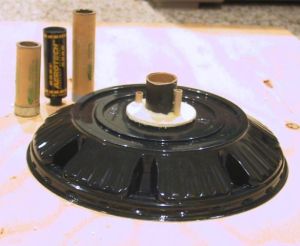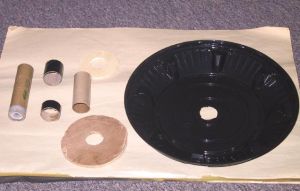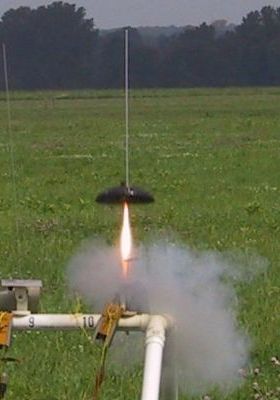Scratch Pi R Feared (In Crust we Thrust) Original Design / Scratch Built
Scratch - Pi R Feared (In Crust we Thrust) {Scratch}
Contributed by Scott Turnbull
| Manufacturer: | Scratch |

Brief:
This rocket is a modification of a plastic pie plate into a 24mm powered
saucer.
Construction:
The Bill of Materials for Pi-R-Feared is extremely short:
- 1 bottom of store bought pie packaging
- 1 3" long 24mm Motor Tube
- 1 2.25" Centering Ring
- 1 3.75" Centering Ring
- 1 piece of body tube slightly larger than motor mount tube
- 2 launch lugs for 3/16" rod
As we finished up a store bought pie and I prepared to throw away the vacuformed packaging, I noticed the complex molded rings, ribs, and indentations used to stiffen the thin, black PETE 1 plastic. When turned upside down, the angled sides of the packaging reminded me of a classic '50s Sci-Fi saucer shape. After a quick rinse, into the project bin it went. Cost: $0.00, if you consider the pie it contained worth the price of admission.
I used a section of scrap 24mm motor mount tube to mark the center of the pie plate. A razor knife quickly produced a central hole. A set of spring steel circular saw blades for a drill was used to fashion a 2.25" centering ring from Clementine fruit crate plywood. An appropriate hole was also drilled into a piece of luan plywood roughly cut into a 3.75" centering ring.
 The bottom side of the pie packaging base became the
top side of the saucer. I used Gorilla Glue to glue the small ring to the
saucer top, the large ring to the inside of the saucer, and the motor mount
through the assembly. The tube extends 3/4" below the inside ring and 1
1/4" above the upper ring. I cut two sections of scrap, black body tube
that was a loose fit over the 24mm motor tube. I Gorilla Glued these black
tubes to cover the two sections of exposed motor tube. A Gorilla Glue fillet
was formed where the black body tubes contacted the centering rings. The
Gorilla Glue foamed up to fill the slight gap between the black tube and the
motor mount. With this arrangement, the motor mount was locked in place between
the black tubes and centering rings. The glue joint to the plastic is not load
bearing, as the glue to the black sleeves, motor mount, and centering rings
traps the plastic between the rings.
The bottom side of the pie packaging base became the
top side of the saucer. I used Gorilla Glue to glue the small ring to the
saucer top, the large ring to the inside of the saucer, and the motor mount
through the assembly. The tube extends 3/4" below the inside ring and 1
1/4" above the upper ring. I cut two sections of scrap, black body tube
that was a loose fit over the 24mm motor tube. I Gorilla Glued these black
tubes to cover the two sections of exposed motor tube. A Gorilla Glue fillet
was formed where the black body tubes contacted the centering rings. The
Gorilla Glue foamed up to fill the slight gap between the black tube and the
motor mount. With this arrangement, the motor mount was locked in place between
the black tubes and centering rings. The glue joint to the plastic is not load
bearing, as the glue to the black sleeves, motor mount, and centering rings
traps the plastic between the rings.
I used a drill to bore a hole alongside the black tube through the upper ring, plate, and lower ring. I used yellow carpenter's glue to glue a launch lug for a 3/16" rod up against the black body tubes. In hindsight I realized that a motor with a thrust shoulder would overhang the motor mount and block the launch lug, so I installed another lug on the other side of the motor mount about 1/4" away from the tube.
That's all there is to it. No positive retention device was installed so that a variety of engine lengths could be used. Longer engines simply extend up above the upper motor tube end.


Flight and Recovery:
The first flight of Pi-R-Feared (In Crust We Thrust) was on a D12-5. I expected
the ejection would be well past apogee but would still be in the air. Masking
tape was used to create an engine thrust ring and the motor was friction fit.
The bargain basement saucer leapt off the pad, arced over at the end of thrust,
and blew its ejection charge like a retrorocket as it neared the ground. The
best part is that the charge knocked the saucer to the side, and it landed
squarely in a 5 gallon spackle bucket placed under the launch rack a few feet
from where it launched from. 2 points! The crowd at NyHiPower was duly amused.
Hoots and hollers rang out.
Another flight of Pi-R-Feared was on an E15-4. This time, "the little saucer that could" leapt from the pad with a waggling boost to a respectable altitude. When the ejection charge fired just past apogee, a spot of bright flame could be seen as the saucer descended. I raced to the landing spot, in fear of finding a tube on fire, but it turned out the flame was from the burning of the white paper disk that seals in the ejection charge. No harm, no foul, no fire.
Summary:
This was an extremely easy build that was done in under an hour and was a
virtually free project if you have a few scrap tubes in your bin.
Sponsored Ads
 |
 |











